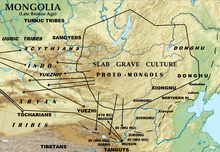Plate burial culture
| Prehistoric cultures of Russia | |
| Mesolithic | |
| Kunda culture | 7400-6000 BC Chr. |
| Neolithic | |
| Bug Dniester culture | 6500-5000 BC Chr. |
| Dnepr-Don culture | 5000-4000 BC Chr. |
| Sredny Stog culture | 4500-3500 BC Chr. |
| Ekaterininka culture | 4300-3700 BC Chr. |
| Fatyanovo culture | around 2500 BC Chr. |
| Copper Age | |
| North Caspian culture | |
| Spa culture | 5000-3000 BC Chr. |
| Samara culture | around 5000 BC Chr. |
| Chwalynsk culture | 5000-4500 BC Chr. |
| Botai culture | 3700-3100 BC Chr. |
| Yamnaya culture | 3600-2300 BC Chr. |
| Afanassjewo culture | 3500-2500 BC Chr. |
| Usatovo culture | 3300-3200 BC Chr. |
| Glaskovo culture | 3200-2400 BC Chr. |
| Bronze age | |
| Poltavka culture | 2700-2100 BC Chr. |
| Potapovka culture | 2500-2000 BC Chr. |
| Catacomb tomb culture | 2500-2000 BC Chr. |
| Abashevo culture | 2500-1800 BC Chr. |
| Sintashta culture | 2100-1800 BC Chr. |
| Okunew culture | around 2000 BC Chr. |
| Samus culture | around 2000 BC Chr. |
| Andronovo culture | 2000-1200 BC Chr. |
| Susgun culture | around 1700 BC Chr. |
| Srubna culture | 1600-1200 BC Chr. |
| Colchis culture | 1700-600 BC Chr. |
| Begasy Dandybai culture | around 1300 BC Chr. |
| Karassuk culture | around 1200 BC Chr. |
| Ust-mil culture | around 1200–500 BC Chr. |
| Koban culture | 1200-400 BC Chr. |
| Irmen culture | 1200-400 BC Chr. |
| Late corporate culture | around 1000 BC Chr. |
| Plate burial culture | around 1300–300 BC Chr. |
| Aldy Bel culture | 900-700 BC Chr. |
| Iron age | |
| Baitowo culture | |
| Tagar culture | 900-300 BC Chr. |
| Nosilowo group | 900-600 BC Chr. |
| Ananino culture | 800-300 BC Chr. |
| Tasmola culture | 700-300 BC Chr. |
| Gorokhovo culture | 600-200 BC Chr. |
| Sagly bashi culture | 500-300 BC Chr. |
| Jessik Beschsatyr culture | 500-300 BC Chr. |
| Pazyryk level | 500-300 BC Chr. |
| Sargat culture | 500 BC Chr. – 400 AD |
| Kulaika culture | 400 BC Chr. – 400 AD |
| Tes level | 300 BC Chr. – 100 AD |
| Shurmak culture | 200 BC Chr. – 200 AD |
| Tashtyk culture | 100–600 AD |
| Chernyakhov culture | AD 200–500 |

The plate grave culture was in the late 2nd and 1st millennium BC. In Transbaikalia and northern Mongolia and thus belonged to the late Bronze Age and early Iron Age in this region.
The eponymous plate graves are characteristic. They are stone boxes , an enclosure made of stone slabs. The dead were buried lying on their backs with their heads facing the east, sometimes with animal skulls, especially horse skulls, a custom that was also widespread among the Xiongnu . The find material is kammabdruck- and notch afford decorated ceramic characterized. Chinese influences can also be seen in the ceramics; At the same time, connections to the upper Yenisei area can also be identified. Settlements have not yet been excavated; they are only known from reading finds. The economy was most likely dominated by livestock. The people of the plate grave culture were probably the earliest nomads in the region. Due to the rich natural resources, metallurgy was also practiced. The ethnicity of the bearers of the plate grave culture cannot be determined with certainty. The skeletons appear to have Asian features. The origin of the plate grave culture is controversial, in some elements, such as the funeral customs (stretched supine position with face to the east) and the ceramics, it shows similarities with previous cultures in the region. The previous Glaskovo culture may have played a role in this , but its bearers still lived semi-nomadically on modest arable farming and wintry mobile cattle breeding, in some regions heavily supplemented by hunting, fishing and gathering and which also moved from the south into the Baikal Region had spread. In the 3rd century BC The plate grave culture was replaced by the Xiongnu.
literature
- Hermann Parzinger : The early peoples of Eurasia. From the Neolithic to the Middle Ages ( Historical Library of the Gerda Henkel Foundation ). Beck, Munich 2006, ISBN 3-406-54961-6 , pp. 474 ff., 631 ff., Fig. 159, 206.
- Н. Л. Тсчленоща: Культура плиточных могил. In: Марина Г. Мошкова (Ed.): Степная полоса азиатской части СССР в скифо-сарматское время (= Археология СССР. ). Наука, Москва 1992, ISBN 5-02-009916-3 .
- Александр Дондопович Цыбиктаров: Заглавие Культура плиточных могил Монголии и Забайкалья. госуниверситета, Улан-Удэ 1998, ISBN 5-85213-129-6 .
Footnotes
- ↑ The dates in the table are taken from the individual articles and do not always have to be reliable. Cultures in areas of other former Soviet republics were included.
- ↑ Parzinger pp. 474-478, 521-525. Igor V. Naumov; David Collins: The History of Siberia. New York 2006, p. 27.
- ↑ Parzinger pp. 474-478.
- ↑ Parzinger pp. 475-476.
